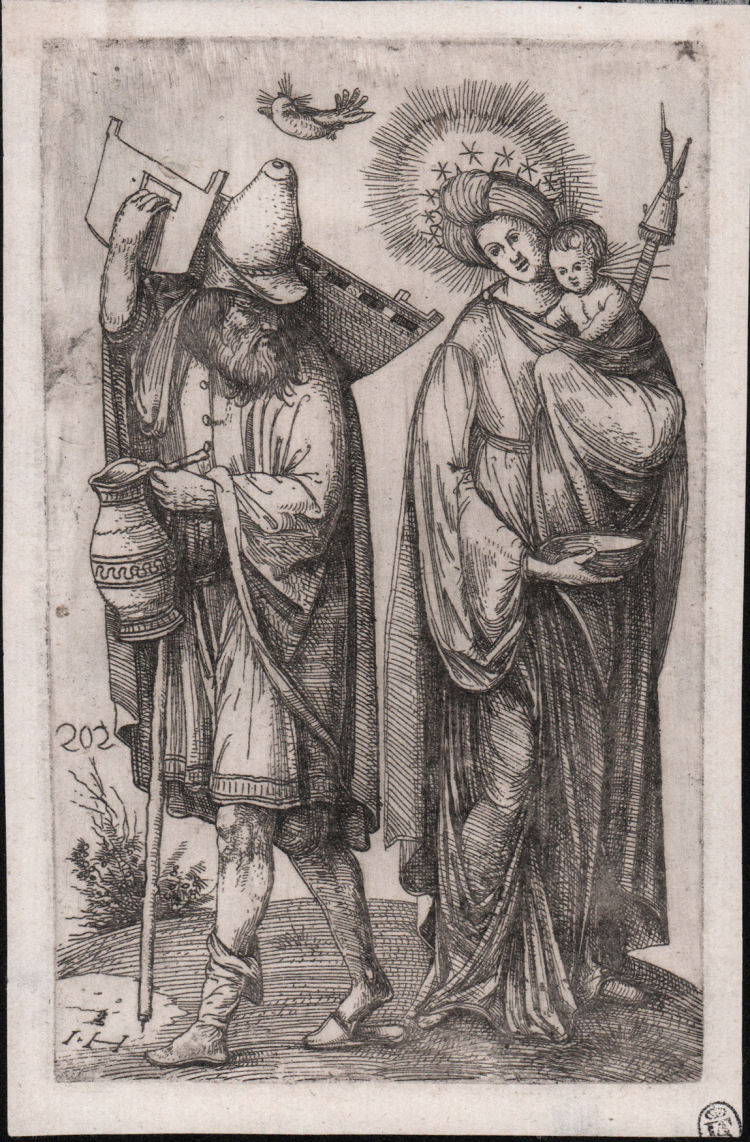




| Reference: | S28062 |
| Author | Hieronimus HOPFER |
| Year: | 1530 ca. |
| Measures: | 84 x 135 mm |



| Reference: | S28062 |
| Author | Hieronimus HOPFER |
| Year: | 1530 ca. |
| Measures: | 84 x 135 mm |
Holy Family; the Virgin and Christ Child with a distaff on right, Joseph with a cradle, jug and staff standing on left, a dove above Joseph's head.
Etching of iron, monogrammed on plate at the bottom left 'I.H'.
Derivation, in reverse, the work of Jacopo de 'Barbari (Hind 16 & 17).
Example in the second state of two, with the added number “202” at the left edge.
Hieronymus Hopfer (Augsburg, c. 1500 - Nuremberg, after 1550) was born around 1500 as the second son of Daniel Hopfer. Only few biographical data are known: in 1529 the Augsburg City Council allowed him to go to Nuremberg for a year while, in 1531, Hopfer completely renounced his traditional civil rights and after 1550 he died in Nuremberg. Most of the known works are copies based on woodcuts and engravings by German (Dürer, Cranach) and Italian (Barberi, Campagnola, Mantegna) artists, as well as engravings based on medals and reliefs. Unlike Dürer and the other Nuremberg masters of engraving, Hieronimus Hopfer used to make his works in etching and on iron plate rather than copperplate, a technique in which he was a specialist along with the other members of the engraving family, his father Daniel and brother Lambert Hopfer.
The new technique in printmaking (although long used to decorate metalwork), etching involved biting lines into an iron plate with acid rather than scraping them with a burin. The earliest surviving print in the technique - by Urs Graf - dates from 1513. Dürer’s brief experimentation with this form of printmaking, between 1515 and 1518, does not appear to have proved particularly satisfying to him, and he soon concentrated on engraving, his preferred method of incising a plate.
Magnificent proof, printed with tone on contemporary thin paper, with margins, in good condition.
Collection's marks on recto and verso: Frederick Augustus of Saxony (Lugt 971); Ines Beckendorf Kaps (Lugt 3575); Ines Kaps (Lugt 3551); Collezione non identificata (Lugt 5176).
Bibliografia
Hollstein, German engravings, etchings and woodcuts c.1400-1700 (6.II); Bartsch, Le Peintre graveur (VIII.507.4)
Hieronimus HOPFER (Augsburg 1500 circa - Norimberga 1563)
|
The Hopfers were a German family of engravers. In 1497 Daniel Hopfer married Justina Grimm, sister of the publisher and humanist Sigismund Grimm. From the marriage were born sons Hieronymus and Lambert, who followed their father's profession and worked with him. Daniel made more than 130 prints of various subjects for the market of the time, Hieronymus 77 and Lambert 34. They placed their initials within the design in almost all of their prints (D.H., I.H., L.H.), adding a small emblem, such as the pine cone in the Augsburg city coat of arms, or a hop flower, in reference to the family name. Hieronymus Hopfer (Augsburg, c. 1500 - Nuremberg, 1563) was born around 1500. Only few biographical data are known: in 1529 the Augsburg City Council allowed him to go to Nuremberg for a year while, in 1531, Hopfer completely renounced his traditional civil rights and after 1550 he died in Nuremberg. Most of the known works are copies based on woodcuts and engravings by German (Dürer, Cranach) and Italian (Barberi, Campagnola, Mantegna) artists, as well as engravings based on medals and reliefs. Unlike Dürer and the other Nuremberg masters of engraving, Hieronimus Hopfer used to make his works in etching and on iron plate rather than copperplate, a technique in which he was a specialist.
|
Hieronimus HOPFER (Augsburg 1500 circa - Norimberga 1563)
|
The Hopfers were a German family of engravers. In 1497 Daniel Hopfer married Justina Grimm, sister of the publisher and humanist Sigismund Grimm. From the marriage were born sons Hieronymus and Lambert, who followed their father's profession and worked with him. Daniel made more than 130 prints of various subjects for the market of the time, Hieronymus 77 and Lambert 34. They placed their initials within the design in almost all of their prints (D.H., I.H., L.H.), adding a small emblem, such as the pine cone in the Augsburg city coat of arms, or a hop flower, in reference to the family name. Hieronymus Hopfer (Augsburg, c. 1500 - Nuremberg, 1563) was born around 1500. Only few biographical data are known: in 1529 the Augsburg City Council allowed him to go to Nuremberg for a year while, in 1531, Hopfer completely renounced his traditional civil rights and after 1550 he died in Nuremberg. Most of the known works are copies based on woodcuts and engravings by German (Dürer, Cranach) and Italian (Barberi, Campagnola, Mantegna) artists, as well as engravings based on medals and reliefs. Unlike Dürer and the other Nuremberg masters of engraving, Hieronimus Hopfer used to make his works in etching and on iron plate rather than copperplate, a technique in which he was a specialist.
|